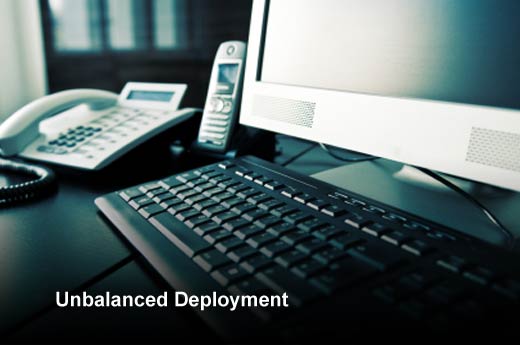Small to medium businesses (SMBs) relentlessly seek new strategies and solutions to reduce costs and increase productivity. Every saved dollar goes back to the bottom line to fuel growth. Costs can be recovered in many areas across the office.
One of the most common sources of unnecessary spending is found in the misallocation of office technology. Significant losses occur with underused printers, multifunction printers (MFPs) and document management systems. This misallocation has a number of cost and productivity implications but can be remedied by identifying underused devices and deploying resources more effectively.
About the Author
Dan Waldinger is the director, Services and Solutions Marketing, Brother International Corporation. With more than 25 years of industry experience, Mr. Waldinger leads the Brother SMB initiative, Don’t Supersize. Optimize. Under his leadership, Brother provides resources, self-assessment tools and solutions for SMBs to reduce document-related costs and increase efficiencies.
Data source: InfoTrends whitepaper “Device Underuse and Unbalanced Fleets”

Click through for more on the challenges and financial implications caused by unbalanced printer deployment, as well as solutions to help SMBs save money, provided by Dan Waldinger, director of marketing, Solutions & Services at Brother International.

Reduced Demand for High-Capacity Machines
Studies show a steady decline in printing. Many MFPs are capable of printing at least 100,000 pages per month. However, data shows that SMBs typically print no more than 10,000 pages per month. This 90 percent underuse wastes valuable capital.
Reduced print volumes can be attributed to a number of factors. Many SMB employees choose to work from smartphones and tablets rather than from printed documents. And automated workflow systems usher electronic documents between decision-makers without consuming paper. Most SMB print jobs are now five pages or fewer, and the decline in print volumes will persist as more operations move from paper to digital.

Underused Features
Hardcopy booklets and presentations are rarely printed, in favor of digital white papers and online slide shows. This leaves MFPs stagnant with unused “finishing features” such as stapling, hole-punching and folding – features that are becoming nearly obsolete. For example, reports show that SMBs utilize color A3 (11 x 17) booklet-making features only about 10 percent of the time.
Alternate paper formats such as 11 x 17, also known as “ledger” and “A3,” are infrequently used by most SMB workers. In fact, a recent study finds that only 2 percent of all office jobs are printed in A3 size.

Unbalanced Deployment
One of the most overlooked areas of waste comes through the ineffective deployment of devices. The trend of managed print services and printer fleet optimization has resulted in many SMBs reducing the size of their fleets, acquiring MFP devices and centralizing the placement. In many instances, this strategy produced an unforeseen downside, creating an environment that hinders worker productivity.
More workers are sharing devices than ever before. In the past, the closest printer may have been just a few feet away. Today it may be more than 100 feet away, hindering the speed of business and the demand for anytime, anywhere access to information and technology. The ineffective deployment of devices can result in higher costs and productivity losses.

Financial Implications
The under-usage and poor deployment of office devices have significant cost and productivity implications. MFPs with unnecessary features are more expensive to purchase and lease than machines that modern SMB workers actually need. Further losses occur when bloated devices are under contract, as pricing is often based on an expected level of monthly print volume that does not match the needs of most SMBs.
In most cases, sparsely dispersed, unnecessary devices are not the most financially appropriate option for SMBs. Stats from InfoTrends show that SMB employees waste more than 4,000 hours and nearly $130,000 per year walking to and from copiers and printers. SMBs can increase employee productivity and reduce costs simply by improving device allocation and re-thinking purchase strategies.
Further loss is incurred as unnecessary, large-footprint devices consume additional energy, require more maintenance and consume extra space. These devices also tend to require more staff intervention, further burdening productivity.

Optimizing for Efficiency
Armed with this knowledge, there are a number of ways that SMBs can significantly reduce device-related waste through more balanced deployment. It begins by assessing organizational needs. Once identified, MFPs with unnecessary features can be replaced with printers that address the organization’s specific needs, and then appropriately deployed throughout the organization. Arranging these devices in key locations can help SMBs achieve significant productivity gains as well as cost savings.
For example, an office with large MFPs can move to just one color laser printer for the marketing department, an A3 device for legal affairs and a number of low-cost black-and-white letter-size machines deployed close to employee work areas. This strategy would save the SMB in every area, from leasing costs to energy usage and increased employee productivity.
SMBs can also maximize cost savings and productivity through software and services that improve business processes. For example, print management/cost recovery solutions can automate a range of print, copy and scan tasks, including activity tracking, cost allocation, quota setting/enforcement, secure printing, job redirect and reporting. Other cost-saving tools can capture scanned documents, route them to the proper destinations and retrieve scanned information at a later date.
Software solutions are also available for business processes as well as security and compliance requirements. For example, health care organizations can utilize software to securely integrate MFPs with electronic medical records (EMR) or claims management systems, enabling jobs to be properly transmitted to the appropriate repositories.














